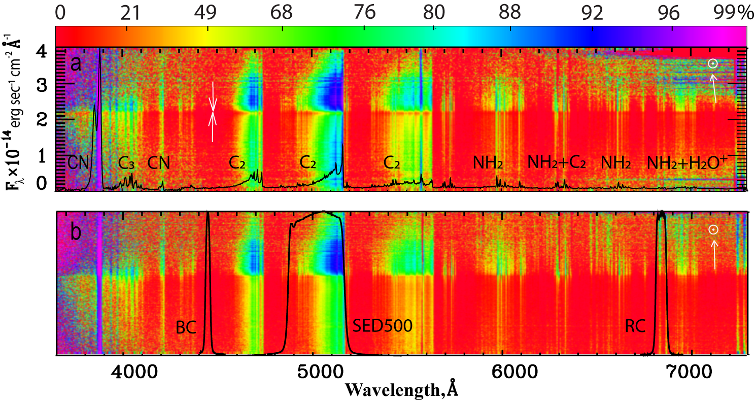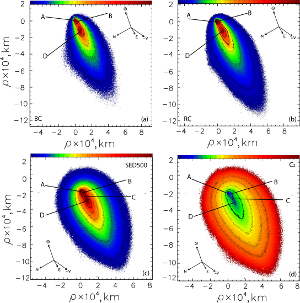|
As the decay of the nucleus into fragments is not common in comets, it is
observed very rarely. About 40 comets have been observed after their
splitting in the last 150 years.
The partial fragmentation of the cometary nucleus or its complete
disintegration allows us to study the process regarding nucleus mass loss,
internal structure, and composition of the nucleus. There are two main
types of comet splitting: comets, the nuclei of which disintegrate
into several large fragments (secondary nuclei), and comets, the nuclei
of which disintegrate into small fragments, and the object itself
"disappears" catastrophically, as happened with the
long-period comet C/2019 Y4 (ATLAS).
Spectroscopic and photometric observations of the comet C/2019 Y4 (ATLAS)
were carried out at the 6-m telescope BTA of the SAO RAS using the SCORPIO-2
focal reducer.
The comet was observed during the disintegration of its nucleus on April 14
and 16, 2020, when it was at heliocentric distances of 1.21 and 1.17 au,
47 and 45 days before its perihelion, respectively.
Based on photometric studies, four fragments belonging to the coma were
detected in both observational runs. They were visible both in the continuum
and in emission lines, which indicates the formation of four "mini-comets"
as a result of the split of the main nucleus. Spectral observations showed
that the disintegration of the nucleus led to a significant increase in
the proportion of gas in the cometary coma. The distribution of the gas
component was asymmetric for solar-antisolar directions. A change in the
color of the dust along the cometary coma was found: the color changed
from red, near the main component of the nucleus, to very blue, at the
periphery of the cometary coma. A significant difference in
the coma color behavior is associated with the asymmetry of the
contribution of the gas component (the presence of several nuclear
fragments in the coma) and with the evolution of
the scattering properties of particles with a cometocentric distance.
The correlation between the findings on the composition of the gaseous
coma in 2019Y4 and those emerging from the study of its dusty coma is
worth noting. The CN and C2 molecules in a cometary coma could
appear as a result of the disintegration of parental molecules, and also
to evaporate from submicron and/or micron-sized organic particles in the
cometary jets. The high abundance of C2 and CN molecules in a
coma observed in the spectral and photometric data, and the absence of
the negative polarization is an indicator of the predomination of
highly absorbing particles, whose refractive index corresponds to organic
materials.

Fig.1.
Spectral observations of comet C/ 2019 Y4 (ATLAS) on April 14 (top) and
April 16, 2020 (below). The contribution of the gas component to the total
flux (in percent) in each pixel of the slit image is shown in the form of
a color diagram. The spectrum of the comet (a) and the normalized
transmission curves of the чу, RC, and SED500 filters (b) are
superimposed on the diagram.
|

Fig.2.
Direct images of comet C / 2019 Y4 (ATLAS) obtained with narrow-band
filters: blue BC continuum (a), red RC continuum (b), the filter focused
at the C2 band system, panel (d) shows the pure C2 intensity map after
the dust-component subtraction. 4 fragments of the nucleus (A, B, C, D)
are marked.
|
Published:
O.Ivanova, I.Luk'yanyk, D.Tomko, A.Moiseev. Photometry and long-slit
spectroscopy of the split comet C/2019 Y4 (ATLAS). / // Monthly Notices
of the Royal Astronomical Society. - 2021. - V. 507(4). - P. 5376-89.
Contact - Ivanova O.,,
DSc, Senior Researcher in Department of Interplanetary Matter in
Astronomical Institute of Slovak Academy of Science
|

